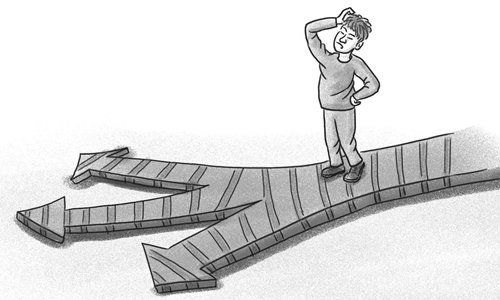Nepal needs to speed up selection of BRI projects to improve local quality of life

Illustration(Global Times/Xia Qing)
The Belt and Road Initiative (BRI) was proposed by China in 2013. Not long after the inception of the initiative, the Nepali government made a full commitment to join.
An all-party consensus exists where Nepal should reap the benefits of the BRI to meet domestic development and prosperity requirements. All concerned parties have expressed unwavering commitment. However, progress has been slow when it comes to selecting and executing BRI projects.
International pressure is the main reason for the delays. Another reason is the lack of government willpower to make decisions regarding the BRI.
Nepal signed a Memorandum of Understanding pertaining to the BRI in May 2017, and though it has been more than two years since the signing of document, there has not been enough progress in selection of projects.
Minister for Foreign Affairs Pradeep Kumar Gyawali said that discussions are underway with China on BRI projects. As BRI seminars are ongoing in Nepal and China, discussions concerning the projects are needed.
Initially, almost three dozen BRI projects were considered, but that number was slashed to a few. Previous discussions focused on a cross-border railway between both countries, which is currently in its initial phase. Rugged terrain, along with other geographical and environmental issues, has yet to be studied. A pre-feasibility report was issued, and discussions are underway with officials from both sides.
During the last two years in Nepal, there has been debate over the construction of a Chinese and Indian railway. However, there is a perception that this would mean a Chinese railway was on its way to Nepal. A railway line sounds attractive to ordinary people.
There is no doubt that Nepal is in need of massive economic investment to build infrastructure and create domestic employment. Under the BRI, Nepal leaders should choose medium and small projects like hydropower and roads that would improve daily life. If realistic projects were chosen after careful risk analysis there would be fewer problems.
We will require massive investments in infrastructure development and the induction of advanced and innovative technology, for which our domestic resources are insufficient. Therefore, we need the support and cooperation of the international community, including our neighbors, to fill in the resource gap, said Pradeep Kumar Gyawali during a speech.
Nepal could select hydropower projects that would help create jobs and generate revenue from selling electricity. Another potential area is road construction, which is key for economic development. Regarding connectivity with China, road infrastructure in the northern region of Nepal remains weak. Due to a lack of proper roads, farmers in rural areas are unable to transport vegetables and fruits to local markets. If new roads were built under the BRI, they would help rural farmers and boost the economy.
Foreign Direct Investment (FDI) has been in decline in Nepal, and the country has passed laws to attract more. Nepal has opened offices aimed at providing FDI services at one location. However, this has not been very effective. More efforts should be put into it. To attract FDI, Nepal needs to be harder on labor and tax issues, but the results would not be immediate.
By 2030, Nepal aims to be a middle-class country, but its economy will not be sufficient to achieve this. Though Nepal has made progress in poverty alleviation, more efforts are still needed. A high annual growth rate of seven to eight percent is necessary, plus $8 billion in FDI to remain on par with the least developed countries.
To achieve their poverty reduction goal and improve people's living standards, Nepal needs to accelerate their selection of BRI projects together with China.
(The author is Kathmandu-based writer and he follows Nepal's neighborhood policy.)
- Nepalese student forms blood bond with Chinese
- Confucius Institute in Nepal lauded during 1st inaugural anniversary
- Wang Yi meets officials from Sri Lanka, Laos, Nepal, Vietnam
- Asia Album: BRI hydropower projects send bliss of development to Laos
- GLOBALink | Huawei explores means to continue to help Nepal go digital

